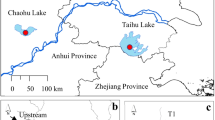Abstract
The partitioning of heavy metals in sediment from Poyang Lake, the largest freshwater lake in China, was studied. The majority of the heavy metals, copper, lead and zinc, were found to be bound to the organic matter and iron oxide phases. The distribution of the metals among the different geochemical phases in sediments was controlled by the abundance of the geochemical phases. An equilibrium adsorption model developed by Oakley et al. (1981) and Davies-Colley et al. (1984) was applied to predict the partitioning of copper among different geochemical phases in the sediments of Poyang Lake. The conditional equilibrium constants (slopes of the linear portions of the adsorption isotherms) were determined using an artificial water-sediment system at various pH's. This model was used to describe the heavy metal partitioning in sediment samples from Poyang Lake and the predicted results were consistent with those measured in the laboratory.
Similar content being viewed by others
References
Brannon, J. M., E. M. Engler, J. R. Rose, P. G. Hunt & I. Smith, 1976a. Distribution of toxic heavy metals in marine and freshwater sediments, In P. A. Krenkel, J. Harrison & J. C. Burdick (eds), Proc. Conf. Dredging and its Environmental Effects, Am. Soc. Civil Eng., New York, 455–495.
Brannon, J. M., J. R. Rose, H. M. Engler & I. Smith, 1976b. The distribution of heavy metals in sediment fractions from Mobile Bay, Alabama. In T. F. Yen (ed.), Chemistry of Marine Sediments, Ann. Arbor Sci. Publ.: 125–149.
Chen Jingsheng, Baoshan Deng, Li Zhang & Yu Peng, 1985. A study on heavy metal pollution in offshore sediments in Jinzhou Bay of Bohai Sea, Acta Scientiae Circumstantiae 5: 129–139 (in Chinese).
Davies-Colley, R. J., P. O. Nelson & K. J. Williamson, 1984. Copper and cadmium uptake by estuarine sedimentary phases, Envir. Sci. Technol. 18: 491–499.
Förstner, U., 1976a. Metal concentrations in recent lacustrine sediments, Arch. Hydrobiol. 80: 172–191.
Förstner, U., 1976b. Metal concentration in freshwater sediments — natural background and cultural effects. In H. L. Golterman (ed.), Interaction between Sediments and Freshwater. Junk. B.V. Publ., Wageningen, 94–103.
Förstner, U., 1976c. Lake sediments as indicators of heavy metal pollution. Naturwissenschaften 63. 465–470.
Förstner, U. & G. Muller, 1976. Heavy metal pollution monitoring by river sediments. Fortschr. Mineral. 53: 271–288.
Förstner, U. & G. T. W. Wittmann, 1979. Metal Pollution in Aquatic Environment. Springer-Verlag, Heidelberg.
Gibbs, R., 1973. Mechanisms of trace metal transport in rivers. Science 180: 71–73.
Gao, Guangshen & Chen, Jingsheng, 1983. Adsorption of cadmium by suspended matter of Chinese main rivers. Envir. Chem. 2: 28–39 (in Chinese).
Hall, K. J. & K. S. Bindra, 1979. Geochemistry of selected metals in sediments and factors affecting organism concentration, In Proc. Intern. Conf. Heavy Metals in Environment, London: 24–56.
Harrison, R. M., D. P. H. Laxen & S. J. Wilson, 1981. Chemical associations of lead, cadmium, copper and zinc in street dusts and roadside soils. Envir. Sci. Technol. 15: 1378–1382.
Huan, Runhua, 1985. Optimum condition for pressure digestion technique of soil and sediment samples used in environmental analysis. J. Envir. Sci. 6: 75–81 (in Chinese).
Institute of Soil Science, 1980. Soils of China. Science Press, Beijing (in Chinese).
Liu, Ching-I & Tang, Hongxiao, 1985. Chemical studies of aquatic pollution by heavy metal in China, Environmental Inorganic Chemistry, VCH Publishers, Inc., 359–371.
Mao, M. Z., C. H. Liu & J. X. Wei, 1981. Studies on the chemical states of heavy metals on the surface of sediments in Xiang Jiang River. Huanjing Kexue 2: 335–348 (in Chinese).
Nissenbaum, A., 1972. Distribution of several metal in chemical fraction of sediment core from the Sea of Okhotsk. Israel J. Earth Sci. 21: 143–154.
Nissenbaum, A., 1974. Trace elements in Dead Sea, Sediments. Israel J. Earth Sci. 23: 111–116.
Nissenbaum, A. & D. J. Swaine, 1976. Organic matter-metal interaction in recent sediments: the role of humic substances. Geochim. Cosmochim. Acta 40: 809–816.
Oakley, S. M., C. E. Delphey, K. J. Williamson & P. O. Nelson, 1980. Kinetics of trace metal partitioning in model anoxic marine sediments. Wat. Res. 14: 1067–1072.
Oakley, S. M., P. O. Nelson & K. J. Williamson, 1981. Model of trace metal partitioning in marine sediments. Envir. Sci. Technol. 15: 474–480.
Qian, Weichen, 1985. Concentration of heavy metals in sediments from Poyang Lake. Envir. Sci. Series 7: 47 (in Chinese).
Turekian, K. K. & K. H. Wedpepohl, 1961. Distribution of the elements in some major units of the earth's crust. Bull. Geol. Soc. Am. 72: 175–192.
Tessier, A., P. G. C. Campbell & M. Bisson, 1979. Sequential extraction procedure for the speciation of particulate trace metals. Anal. Chem. 51: 84.
Tang, Hongxiao & Xue, Hanbin, 1983. The model of aquatic suspended sediments as a multi-component to heavy metals. In Proc. Intern. Conf. Heavy Metals in the Environment, Vol. 2, Heidelberg.
Author information
Authors and Affiliations
Rights and permissions
About this article
Cite this article
Chen, J., Dong, L. & Deng, B. A study on heavy metal partitioning in sediments from Poyang Lake in China. Hydrobiologia 176, 159–170 (1989). https://doi.org/10.1007/BF00026551
Issue Date:
DOI: https://doi.org/10.1007/BF00026551




